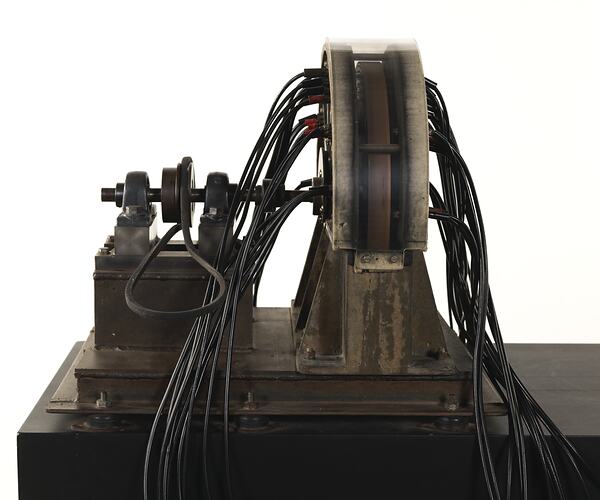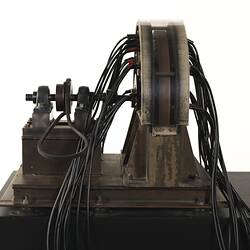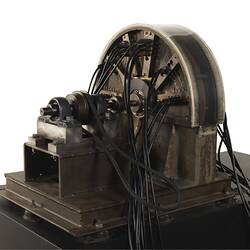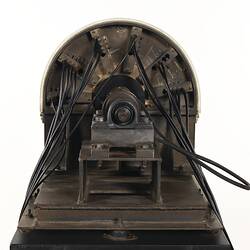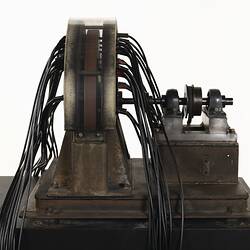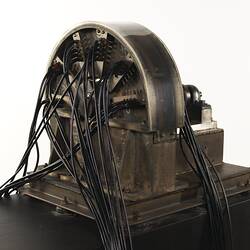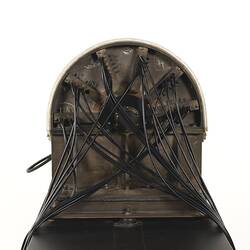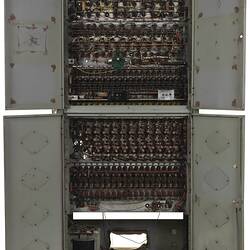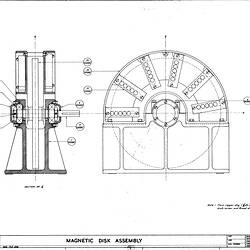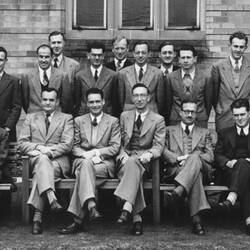Summary
The disk drive was referred to by staff and all users, in Melbourne, as the 'drum'. The original experimental auxiliary store in Sydney was in the form of cylinder hence the continued use of the term 'drum' for the replacememnt in Melbourne.
The approximate capacity of the disk drive (drum) was 5 kb in its final version, being extended from about 2.5 kb in the early 1960s. .The extension was implemented in the read section using transistors. This was the first and only use of transistors in CSIRAC. Transistors were too expensive at that time to use in the extension of the write circuitry so valves were used in that part of the implementation.
The disk itself has a diameter of 296 mm with a thickness of 16 mm. The assembly is 330 mm high, 106 mm wide at its top and 167mm at its base.
The name includes reference to 'Cabinet Back 3' even though there is no third cabinet at the back. The terminology is used simply to identify the location of the disk drive. The auxiliary memory (disk drive) occupied the space that would have been occupied by a cabinet in the back row.
The disk drive (auxilairy store) was controlled by control circuitry in Cabnet Back 2. In Melbourne, the circuitry controlled a magnetic disk. Data were initially stored on one side of the disk. In 1962, in Melbourne, the capacity was increased to include the second side using a new set of read/write circuitry using transistors.
CSIRAC at Melbourne consisted of two rows of cabinets, a control console, input and output devices, test equipment and an off-line paper tape editing area. There were nine cabinets, five in the front row and four in the back. Cool air was blown up through all the cabinets from the basement below.
The five front row cabinets contained (from left to right viewed from the front) power supplies, input and output circuitry, clock and control circuits, arithmetical circuits and memory control circuits. The four back row cabinets contained (from left to right viewed from the front) power supplies, auxiliary store control circuits, 'disk drive', auxiliary test power supplies and memory control circuits.
The date range (1956 - 1964) is given to indicate that, although the metal cabinets were first used in 1949, changes were made to the structure and circuitry over the period of CSIRAC's working life.
More Information
-
Collection Names
-
Collecting Areas
-
Acquisition Information
Donation from Commonwealth Scientific & Industrial Research Organisation (CSIRO), Frank Hirst - University of Melbourne (The), Mar 1965
-
Designer
-
Designer
-
Commissioned By
Commonwealth Scientific & Industrial Research Organisation (CSIRO), Sydney, Greater Sydney, New South Wales, Australia, 1947
-
User
University of Melbourne (The), Grattan Street, Parkville, Greater Melbourne, Victoria, Australia, 1955-1964
-
Classification
-
Category
-
Discipline
-
Type of item
-
Exhibition Collection Management
430 mm (Length), 547 mm (Width), 445 mm (Height), 82 kg (Weight)
attached cables - L1820mm max.
-
References
[Book] McCann, Doug & Thorne, Peter. 2000. The Last of the First CSIRAC: Australia's First Computer. 196., 2000, 9 Pages
[Book] Doornbusch, Paul. 2005. the music of csirac. 101., 2005
-
Keywords
Computers, Computing, CSIRAC (Computer), Making History - CSIRAC
